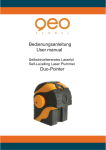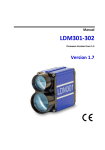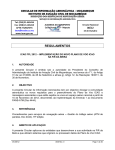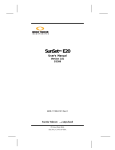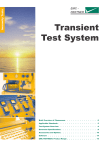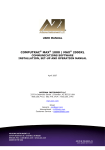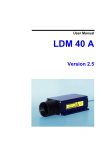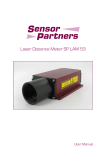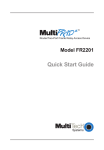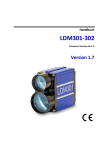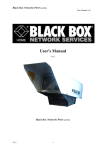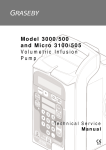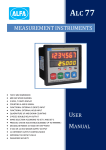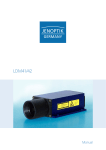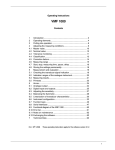Download Laser Distance Meter SP LAM 301
Transcript
Laser Distance Meter SP LAM 301 User Manual 2 Revision 001, May 2007 Dear User You are advised to carefully read this User Manual before you start using the SP LAM 301 Laser Distance Meter. This is necessary to help you exploit all the capabilities which your new Laser Distance Meter offers. We reserve the right to make changes or enhancements in product design as part of ongoing technical progress. Editorial deadline: Documentation number: May 2007 012861-001-98-02-0507-en Sensor Partners BV James Wattlaan 7 5151 DP Drunen Holland Phone: +31 (0) 416-378239 Fax: +31 (0) 416-377439 Web: www.sensor.nl E-Mail: [email protected] Revision state Date Revision Explanatory note May 2007 001 First compiled CE Note No part of this User Manual may be reproduced in any way (by photographing, photocopying, microfilming or any other technique), unless written approval of Sensor Partners BV has been procured, nor may it be processed, duplicated or disseminated with the help of electronic systems. Proper care was used in compiling this document. No liability will be accepted in the event of damage resulting from failure to observe advisory notes or information provided in this User Manual. Revision 001, May 2007 3 Dear User This document uses the following graphic, information and warning symbols to highlight significant description parts: Pictograms and symbols provided for reference • Enumeration + Note/Important/Important note g Reference to (passage of text or illustration) Warning symbols Warning alerts to situations involving potential danger to people’s health if notes of this kind are disregarded. Caution warns of potential damage to the product. Laser warns of potential exposure to emerging visible and invisible laser radiation. Information highlights important details. 4 Revision 001, May 2007 Content 1 2 2.1 2.2 2.2.1 2.2.2 2.3 2.4 2.5 3 3.1 3.2 3.3 4 4.1 4.2 4.3 4.3.1 4.3.2 4.4 4.5 4.5.1 4.5.2 4.5.3 4.6 4.7 4.8 4.8.1 4.8.2 5 5.1 5.1.1 5.1.1.1 5.1.1.2 5.1.1.3 5.1.2 5.1.3 5.1.4 5.2 5.2.1 5.3 5.3.1 5.3.2 5.3.3 General................................................................................................. 9 Safety Notes.........................................................................................11 Basic Information..................................................................................11 Laser Classification................................................................................11 Safety Notes Regarding Laser Class 1....................................................11 Safety Notes Regarding Laser Class 2....................................................11 Electric Power Supply Requirements......................................................11 Important Operating Advice................................................................ 12 Warning Signs & Nameplates............................................................... 12 Intended Purpose................................................................................ 13 General Product Description................................................................ 13 Conforming Use.................................................................................. 13 Non-Conforming Use/Error Sources..................................................... 14 Product Description............................................................................. 15 Scope of Delivery................................................................................. 15 Technical Data..................................................................................... 16 Product Description & Function Elements............................................. 18 Function Elements............................................................................... 18 Models & Equipment Features............................................................. 19 Mechanical Integration Requirements.................................................. 20 Connector Pin Assignments................................................................. 21 Main Connector Port (M18)................................................................. 21 SSI Port (M12)...................................................................................... 22 Profibus Port (M12).............................................................................. 22 Status Display...................................................................................... 23 Pilot Laser............................................................................................ 24 Accessories......................................................................................... 24 Adapter Plate....................................................................................... 24 Anti-Dust Tube.................................................................................... 24 Interface Description........................................................................... 25 Main Connector Port........................................................................... 25 RS232 or RS422 Interface.................................................................... 25 Communication Protocol..................................................................... 25 Wiring................................................................................................. 26 Automatic Baud Rate Detection........................................................... 27 Q1 and Q5 Switching Outputs............................................................. 27 Analog Output QA.............................................................................. 28 Trigger Input........................................................................................ 28 SSI Interface........................................................................................ 28 Specification........................................................................................ 28 Profibus Interface................................................................................ 29 ID Number.......................................................................................... 29 Connection Requirements.................................................................... 29 GSD File.............................................................................................. 29 Revision 001, May 2007 5 Content 5.3.4 5.3.5 5.3.6 5.3.7 5.3.8 5.3.9 5.3.9.1 5.3.9.2 5.3.10 5.3.11 5.3.11.1 5.3.11.2 5.3.11.3 5.3.11.4 5.3.11.5 6 6.1 6.2 7 7.1 7.1.1 7.1.2 7.2 7.2.1 7.2.2 7.2.3 7.2.4 7.2.5 7.3 7.3.1 7.3.2 7.3.3 7.4 7.4.1 7.4.2 7.4.3 7.4.4 7.4.5 7.4.6 7.4.7 7.4.8 7.4.9 7.4.10 7.4.11 6 Slave Address...................................................................................... 29 Bus Termination................................................................................... 29 Baud Rate............................................................................................ 30 Segment Length.................................................................................. 30 Electrical Connection........................................................................... 30 Profibus Firmware Installation.............................................................. 31 Preparation.......................................................................................... 31 Firmware Installation........................................................................... 31 Firmware Update via Profibus.............................................................. 34 SL4 Service Program............................................................................ 34 Setting a Profibus Slave Address on the SP LAM 301PB........................ 34 Parameter Dialog................................................................................. 35 Diag Common..................................................................................... 36 Diag Alarm.......................................................................................... 36 Service................................................................................................ 36 Starting Up.......................................................................................... 37 Preparative Action before Installation................................................... 37 Checklist on Installation Work.............................................................. 37 Measurement...................................................................................... 39 Identification....................................................................................... 39 ID Identification................................................................................... 39 ID?-Online Help................................................................................... 39 Operation Mode.................................................................................. 40 DM – Single Distance Measurement..................................................... 40 DT – Continuous Distance Measurement.............................................. 40 DF – Single Distance Measurement with External Triggering................. 40 VM – Single Speed Measurement........................................................ 40 VT – Continuous Speed Measurement................................................. 40 Status.................................................................................................. 41 TP – Internal LDM Temperature............................................................ 41 PA – All-Parameter Display................................................................... 41 HW – Hardware Diagnosis................................................................... 41 Parameter Setup.................................................................................. 41 AS – Autostart Function...................................................................... 41 PL – Pilot Laser.................................................................................... 42 PR – Reset to Factory Settings.............................................................. 42 DR – Trigger Cold Start........................................................................ 42 SF – Scale Factor.................................................................................. 43 OF - Offset.......................................................................................... 43 SO - Set Offset.................................................................................... 43 MW – Measurement Window............................................................. 43 MF – Measurement Frequency [Hz]...................................................... 44 SA – Average....................................................................................... 44 TD – External Trigger Delay [ms] & Trigger Level [Flanke]....................... 44 Revision 001, May 2007 Content 7.4.12 7.4.13 7.4.14 7.4.15 7.4.16 7.4.17 7.4.18 7.4.19 7.4.20 8 8.1 8.2 8.3 9 9.1 9.2 9.2 10 11 Exhibit 1 Exhibit 2 SE - Error Mode................................................................................... 45 Q1/Q7 – Switching Output................................................................... 45 QA – Analog Output........................................................................... 45 BR – Baud Rate.................................................................................... 46 SD – Serial Interface Termination Character.......................................... 46 TE – Serial Interface Termination Character.......................................... 47 SC - Format SSI.................................................................................... 47 BB – Field Bus Baud Rate..................................................................... 47 AB – Bus Address................................................................................ 47 Preventive Maintenance & Care............................................................ 49 User Maintenance Actions................................................................... 49 Software Update................................................................................. 49 Preventive Maintenance by Sensor Partners BV..................................... 49 Malfunction & Error Messages............................................................. 51 Malfunction........................................................................................ 51 Operating Advice................................................................................. 51 Error Messages.................................................................................... 51 EC Declaration of Conformity............................................................... 53 List of Abbreviations & Glossary........................................................... 55 Adapter Plate....................................................................................... 57 Anti-Dust Tube.................................................................................... 59 Revision 001, May 2007 7 Content 8 Revision 001, May 2007 General 1 General The SP LAM 301 Laser Distance Meter has been developed for use in industrial applications. Its purpose is to allow non-contact measurement of distance and speed within a great working range. Little time and no reflector is required to locate any kind of diffusely reflecting target surface. Available interfacing tools are RS232, RS422, SSI or Profibus, depending on the particularly requested model. These tools are intended for easy installation and start-up of the Laser Distance Meter. A LED display is located on the back panel to facilitate visual tracking of the current work status during normal operation. Compact and robust design, easy mechanical attachment, low power consumption, selectable switching outputs and options for specific user settings are the distinguishing features of the SP LAM 301. Together they create a broad diversity of potential applications in industrial environments. • Process monitoring in steel works and rolling mills • Fill-level measurement • Monitoring of moving objects • Positioning of cranes and loading equipment • Measurement of otherwise inaccessible target points, for example, inside of hollow bodies such as tubes or containers • Position monitoring of road vehicles and ships Standard SP LAM 301 delivery includes integral heating, status display and a telescopic sight. Of modular setup, the Distance Meter readily accepts accessories or custom-manufactured modules for specific applications. Revision 001, May 2007 9 General 10 Revision 001, May 2007 Safety Notes 2 Safety Notes 2.1 Basic Information Safety notes and operating advice must be read carefully and followed at any time during practical use of the SP LAM 301. There is danger of laser radiation or electric shock. For necessary repairs, the SP LAM 301 may not be opened by anyone other than manufacturer personnel. Unauthorized intervention will void any claims for warranty. Specified operating requirements (gsection 4.2) must be met. Failure to comply with these safety notes or non-conforming product usage may cause physical injury to the user or damage to the SP LAM 301. Connectors must not be plugged or unplugged with the SP LAM 301 in powered state. Remember to turn power off before you begin any kind of work for establishing connections. 2.2 Laser Classification The SP LAM 301 is equipped with two lasers: Laser for measurement g laser class 1 Pilot laser g laser class 2 2.2.1 Safety Notes Regarding Laser Class 1 The laser for measurement qualifies as a class 1 laser device in accordance with standard EN 60825-1:2003-10. Laser radiation emitted by class 1 lasers is entirely harmless to the human eye so eye damage can be ruled out for this category. 2.2.2 Safety Notes Regarding Laser Class 2 The pilot laser qualifies as a class 2 laser device in accordance with standard IEC825-1/DIN EN 60825-1:2001-11 and as a class II device under FDA21 CFR. In the event of accidental short-time exposure, the human eye is normally protected by its own lid-closing reflex and preventive reaction. The natural lid-closing reflex may however be impaired by the influence of medication, alcohol or drugs. Despite that, one should refrain from directly looking into the laser beam. Do not point the laser beam onto people. Warning: Class 2 laser radiation – do not look into the beam! 2.3 Electric Power Supply Requirements For normal operation of the SP LAM 301, direct voltage supply of 10 V to 30 V is required. For operation with heating, direct voltage of 24 V should be available. Use only the dedicated connector port for power supply. Observe specified limit values for input voltages. Outputs must not be used as inputs. Revision 001, May 2007 11 Safety Notes All outputs are short-circuit proof. The LDM casing is electrically isolated from the sensor electronics. Immunity to electrostatic discharges (ESD) is 4 kV according to EN 61000-4-2. 2.4 Important Operating Advice To be able to exploit all capabilities and performance features and achieve a long service life of the system, you should follow all of the following rules: • The SP LAM 301 must not be powered up if optical surfaces are found to be misted up or contaminated! • Optical surfaces must not be contacted with bare hands! • Use utmost caution when removing dust or dirt from an optical component! • Prevent shock impacts during operation and transportation of the SP LAM 301! • Protect the SP LAM 301 from overheating! • Protect the SP LAM 301 from strong temperature variations. • The SP LAM 301 provides splash-proofness and dust-proofness under IP67 internal protection level. These safety and advisory notes must be read carefully and followed during practical use of the SP LAM 301. 2.5 Warning Signs & Nameplates LASER RADIATION DO NOT STARE INTO BEAM CLASS II LASER PRODUCT P<0,95mW l=620 … 690 nm EN 60825-1: 2001-11 Fig. 1: SP LAM 301 - Warning Signs & Nameplates 12 Revision 001, May 2007 Intended Purpose 3 Intended Purpose 3.1 General Product Description The SP LAM 301 is a Laser Distance Meter for determining the distance to objects in motion or stationary with centimeter accuracy for: - natural surfaces with 90% reflectance in the range of 0.5 m to 300 m - reflector surfaces (e.g. Scotchlite 3000x) from 300 m to 3000 m and - speed measurement in the range of 0 m/s to 100 m/s (at 0.5 m to 700 m distance). With the help of a red laser sighting point (pilot laser) a given target can be unequivocally identified. The actual range of measurement depends on the reflectivity and the surface quality of a target being measured. The SP LAM 301 relies on the time-of-flight-measurement principle for operation. It is available with RS232 or RS422, depending on the Customer’s request. Product manufacturing includes the installation of a requested configuration. Once installed, the interface cannot be replaced with another type. (g section 4.1 Scope of Delivery) The SP LAM 301 has two switching outputs and one external trigger input (all of them parameterizable). A distance measurement can be triggered: • via RS232 interface or RS422 interface • via Profibus DP-V0 • by an external source (in external trigger mode) • via SSI. The SP LAM 301 is delivered in a stable cardboard box with adequate padding which can also be used for protected transportation of the Laser Distance Meter. 3.2 Conforming Use • Measurement of distance and speed and output of measured data via RS232 or RS422 interface or SSI or Profibus • Special measuring functions • Compliance with environmental requirements, operating temperature and storage temperature • Operation in industrial environments that meet IP67 internal protection standard requirements (allowing for splashes of water and spray) • Operation at correct voltage level • Applying only specified signal levels to data lines • Measurement through an optically transparent medium such as glass, optical filters or plexiglass should be performed with the measuring window function turned on. Revision 001, May 2007 13 Intended Purpose 3.3 14 Non-Conforming Use/Error Sources • Operate the SP LAM 301 only in accordance with its intended purpose and in a proper working condition. • Safety devices must not be defeated. • Information and warning signs must not be removed. • Repair work on the SP LAM 301 may not be performed by anyone other than personnel from Sensor Partners BV. • Do not operate the SP LAM 301 in an explosive environment. • In order to obtain precise measurement results, make sure you follow these rules: - Measurement against the sun or other strong sources of light may lead to faulty readings. - Measurement of target surfaces with poor reflectance, but otherwise surrounded by a highly reflecting environment, may lead to faulty readings. - Measurement of strongly reflecting surfaces may lead to faulty readings. - Measurement through an optically transparent medium such as glass, optical filters, plexiglass, etc. may lead to faulty readings. - Rapidly changing conditions of measurement (e.g. jumps in distance) may lead to faulty readings. Revision 001, May 2007 Product Description 4 Product Description 4.1 Scope of Delivery Description Bestell-Nr. SP LAM 301.100 RS232 012861-005-22 SP LAM 301.200 RS422 012861-009-22 SP LAM 301.101 SSI, RS232 012861-013-22 SP LAM 301.102 PB, RS232 012861-017-22 CD with Customer documentation 2m combi-cable 012840-144-24 5m combi-cable 012840-145-24 10m combi-cable 012840-146-24 “red.dot” telescope 98911 100mm anti-dust tube 012861-025-10 Adapter plate 012861-020-26 PB-In-Out, 5m cable 012840-170-24 PB-In, 5m cable jack 012840-165-24 PB-In, 10m cable jack 012840-166-24 PB-Out, 5m cable connector 012840-160-24 PB-Out, 10m cable connector 012840-161-24 Protective cap for PB jack 94366 Protective cap for PB connector 94363 Jack, 12-pole 94477 PB 12V terminating resistor 94145 PB-jack, 5-pole 94136 PB-connector 5-pole 94133 Product configuration Integrated pilot laser, status display and heating are standard equipment items of all SP LAM 301 models. An overview of the various models and their configuration is contained in the following table. On special request, SP LAM 301s can also be manufactured to provide a divergence of 10 mrad and/or a measuring rate of 10 kHz. Model Interface (x) Divergence (y) Measuring rate (y) Interface (z) Description Ordering code RS232 RS422 2 mrad 10 mrad 2 kHz 10 kHz SSI Profibus LAM301.100 012861-005-22 LAM301.200 012861-009-22 LAM301.101 012861-013-22 LAM301.102 012861-017-22 Table 1: Basic unit configurations Revision 001, May 2007 15 Product Description SP LAM xyz 301. 0 – no additional interface 1 – SSI 2 – Profibus DP 0 - 2mrad / 2 kHz 1 - 2mrad / 10 kHz 2 - 10mrad / 2 kHz 3 - 10mrad / 10 kHz 1 – RS232 2 – RS422 Fig. 2: SP LAM 301 - product identifier 4.2 Technical Data Measuring features Measuring principle Measured quantity Measuring range *1 Measuring accuracy Measured-value resolution Measuring time Measured quantity Measuring range Measuring time Laser-pulse-time-of-flight measurement Distance 0.5 m to 300 m on natural surfaces*² 0.5 m to 3000 m on target board ± 20 mm (for measured-value output at 100 kHz) ± 60 mm (for measured-value output at 2 kHz) 1 mm Standard version: 0.5 ms Special version: 0.1 ms Speed 3 0 ms-1 to 100 ms-1 0.1 s to 0.5 s *1 depending on target reflectance, stray-light influences and atmospheric conditions *2 natural, diffusely reflecting surfaces *3 distance range to targets being measured: 0.5 m to 700 m Laser Laser for measurement Laserklassifizierung Laser beam divergence 16 Wavelength Laser class 1 under EN 60825-1:2003-10 Standard version: 1.7 mrad Special version: 10 mrad 905 nm (infrared, invisible) Pilot laser Laser classification Wavelength Laser class 1 under EN 60825-1:2003-10 635 nm (red) Revision 001, May 2007 Product Description Electric power requirements Supply voltage Power consumption Interfaces/terminals Terminals Serial interfaces Profibus Profibus Transfer rate Ident number Baud rate detection Terminating resistor Slave address GSD file SSI Transfer rate Signal input/output Electrical isolation LSB MSB Switching output Analog output Trigger for device synchronization Operating modes Revision 001, May 2007 10 V to 30 V DC < 5 W (without heating) 11.5 W (with heating, 24 V) 1 x 12-pole (BINDER-series 723) M18 2 x 5-pole (BINDER-series 766) M12 B-encoded RS232 and RS422 with 9.6 kbaud to 460.8 kbaud Format: 8N1, ASCII transmission protocol DP-V0 slave | IEC 61158 / IEC 61784 9,6 kbaud to 12 Mbaud 0x0AA2 Automatic External Selectable via SSA command LDM30AA2.GSD, class 1/2 PNO-profile encoder Configuration of measured quantities, switching outputs, trigger input and powering-up characteristics Output of measured distance values or error message, query for inner device temperature Storage of all parameters and PB address in NVRAM 50 kHz to 1 MHz, 25 µs pause Differential signal (RS422) 24 bits, binary or gray-encoded 1 validity bit 500 V for signal input Bit 0 Bit 23 2 x “high-side switch” | up to 0.2 A load capacity | sustained short circuit proof | selectable window functions 4 mA to 20 mA 1 x trigger In/Out, up to 30 V DC load capacity | edge and delay selectable Single measurement | continuous measurement | mean value | external triggering | selectable nearfield suppression and window functions 17 Product Description Environmental & operating requirements Operating temperature - 40 °C to + 60 °C Storage temperature - 40 °C to + 70 °C Rel. air humidity 15 % to 90 % Phys. dimensions (L x W x H) 136 mm x 57 mm x 104 mm Weight About 800 g (depending on configuration) Type of protection IP67 EMC EN 61000-6-2, EN 55011 4.3 Product Description & Function Elements 4.3.1. Function Elements The casing consists of a robust, corrosion-resistant extrusion-molded aluminum structure with a front cover plate and a back cover plate equally corrosion-resistant. On each lateral side and on the underside of the SP LAM 301 casing there are three support pads with mounting holes (M4) for mechanical attachment of the SP LAM 301 (g Fig. 5 and 6 ). 8 9 2 13 10 11 1 14 3 12 4 5 7 6 Fig. 3: SP LAM 301 function elements Legend 18 1 Front tube 9 Nameplate 2 Transmitter optics 10 Status display 3 Receiver optics 11 Main connector port (M18) 4 Front cover plate (anodized) 12 Service screw 5 Receiver optics 5 Casing (aluminum, extruded) 13 Support pads with M4 x 6 threaded inserts 6 Back cover plate (anodized) 14 7 Pilot laser optionale Anschlüsse (Profibus, SSI) (g Fig.: 4) 8 11-mm rail Revision 001, May 2007 Product Description 4.3.2 Models & Equipment Features Model SP LAM 301.100 SP LAM 301.200 SP LAM 301.101 SP LAM 301.102 Interface RS232 (SP LAM 301.100) RS232 RS232 SSI Profibus RS422 (SP LAM 301.200) Interface 1 1 1 2 Terminals 11 Main connector port 4 3 5 1 Main connector port 1 Main connector port 2 M12 dummy plug 4 Profibus-IN (M12-plug) 3 SSI (M12-jack) 5 Profibus-OUT (M12-jack) Note: For reasons of sealing, plug 2 is also installed for SP LAM 301.101 (SSI)! Fig. 4: Rear panel of the various SP LAM 301 models Revision 001, May 2007 19 Product Description 4.4 Mechanical Integration Requirements For integration of the SP LAM 301 Laser Distance Meter, three different versions of mechanical attachment are available. 1. Attachment to a lateral surface For attachment to a desired one of the two lateral surfaces, the SP LAM 301 provides three support pads (g Fig. 6, reference 1) with mounting holes (M4 x 6) 2. Attachment to casing bottom Likewise, the SP LAM 301 provides three support pads (g Fig. 5, reference 1) with mounting holes (M4 x 6) for attachment to the bottom face of its casing 3. Attachment via adap- To replace an LDM300C with an SP LAM 301, an ter plate (replacement adapter plate is required. This plate must be screwed of LDM300C) to the bottom side of the SP LAM 301 (g Fig. 5, reference 1). The adapter plate is specifically shaped and sized to allow the SP LAM 301 to be attached to the mechanical fixing points of an LDM300C. Legend: 1 1 1 Support pads with M4 x 6 threaded inserts 1 Fig. 5: Mechanical fixing points on bottom face 0.5 13.5 30 90.4 123.4 17.5 thread M4 1 21.4 49.5 1 29.5 28.5 38 6.5 50 1 90.4 139.9 Legend: 1 Support pads with M4 x 6 threaded inserts Fig. 6: Fitting dimensions of the SP LAM 301, zero-point location (dimensions in mm) 20 Zero-point of the SP LAM 301 is identical with the outer surface plane of the front cover plate. Revision 001, May 2007 Product Description 4.5 Connector Pin Assignments Depending on the implemented configuration version of the various SP LAM 301 models, different terminal facilities are available for connections. All models share the same type of main connector port (Fig. 4, reference 1). 4.5.1 Main Connector Port (M18) The main connector port (Fig. 3, Ziffer 11) includes the terminal points for voltage supply, for serial data communication, for the two switching outputs, one analog output and for one trigger input. A shielded cable must be used for connection. This cable is optionally available from Sensor Partners BV. K A B J C L H M G D F E weiss white A TxD / RX+ braun brown B RxD / RX- grün green C TRIG gelb yellow D QA grau grey E n.c. / TX- rosa pink F n.c. / TX+ blau blue G VCC rot red H n.c. schwarz black J GND violett violet K Q2 grau/rosa grey/pink L GND rot/blau red/blue M Q1 Color assignments of cable 796030-20-12 (Binder series 425) Fig. 7: Terminal diagram of main connector port Pin Color code of combi cable Ord.-No. 012840-14x-24 RS232 RS422 Description A White TxD RX+ RS232 send data / RS422 receive data + B Brown RxD RX- RS232 receive data / RS422 receive data - C Green TRIG TRIG Trigger input D Yellow QA QA Analog output (4 … 20 mA) E Grey n.c. TX- RS422 send data - F Pink n.c. TX+ RS422 send data + G Blue VCC VCC Supply voltage H Red n.c. n.c. not connected J Black GND GND GND K Violet Q2 Q2 Switching output Q2 L Grey/pink GND GND GND M Red/blue Q1 Q1 Switching output Q1 Table 2: Pin assignments of main connector port Revision 001, May 2007 21 Product Description 4.5.2 SSI Port (M12) Connection to the SSI interface is accomplished via a 5-pole, B-encoded M12 male connector. Shielded cables should be used for connection. 1 2 5 4 3 Fig. 8: connection diagram 4.5.3 Profibus Port (M12) Profibusses connection is via B-encoded 5-pole M12 connectors. Shielded cabling should be used. 2 1 5 3 4 n.c. - not connected Fig. 9 Profibus-IN connection diagram 1 2 5 4 3 Fig. 10: Profibus-OUT connection diagram 22 Revision 001, May 2007 Product Description 4.6 Status display Fig. 11: Status display LED Function Target Reflectance Display Status Off Red blinking Red Yellow Green Green blinking No signal Very weak signal Weak signal Signal available Good signal Very good signal Status Readiness for action Off Red Green No operating voltage Technical defect, operating voltage supplied Ready for action Q1 Switching output 1 Off Yellow Off Operating voltage supplied Q2 Switching output 2 Off Yellow Off Operating voltage supplied Link Interface status No field bus Profibus error Operating voltage supplied, Profibus inactive Operating voltage supplied, Profibus working Off Red Yellow Green Tabelle 3: Status display - functions Revision 001, May 2007 23 Product Description 4.7 Pilot Laser The pilot laser (g Fig. 2, Ziffer 7) is intended to support alignment to a given target point during start-up action of the SP LAM 301. It qualifies as a class 2 laser device and operates at 635 nm (red) in the visible range. The pilot laser is not aligned to emit in a direction parallel with the measurement laser. Instead, its beam intersects with that of the measurement laser at a distance of 75 m. Fig. 9 shows the tolerance on pilot laser position in relation to the invisible measurement laser as a function of the distance to an object being measured: 10 m 75 m 125 m Fig. 12: Tolerance on pilot laser position relative to measurement laser 4.8 Accessories 4.8.1 Adapter Plate An adapter plate can be supplied for mechanical attachment of the SP LAM 301. Once screwed to the bottom of the SP LAM 301, it will provide various application options, including a 1/4 -20 UNC tripod socket. (drawing g Exhibit 1) 4.8.2 Anti-Dust Tube The purpose of the anti-dust tube is to protect the receiver channel from contamination and laterally incident steady light and potential impairment of measuring performance. (drawing g Exhibit 2) 24 Revision 001, May 2007 Interface Description 5 Interface Description For interfacing, the SP LAM 301 provides a main connector port (g Fig.: 3, reference 11) with RS232 or RS422 interface and an additional SSI interface (g Fig.: 4, reference 16) or Profibus interface (g Fig.: 4, reference 18,19), depending on the Customer’s request. 5.1 Main Connector Port 5.1.1 RS232 or RS422 Interface 5.1.1.1 Communication Protocol - Interface settings: asynchronous, 8 data bits, no parity, 1 stop bit - Commands are case-sensitive (no distinction between small lettering and capital lettering) - Period “.” (0x2E) serves as decimal separator for output of numbers - Enter (0x0D) is used as command (send command) termination character - With multi-value parameters, space (0x20) is used between each two values - A parameterization command with new parameters triggers a response command with these parameters - A parameterization command without new parameters triggers a response command with (most recent) parameters - A parameterization command with parameters out of valid setting ranges triggers a response command with (most recent) parameters - An unknown command and a faulty parameter format is quitted via “?” (0x3f) Communication protocol format/syntax: 7-bit ASCII Proprietary communication protocol Command group Command Description Standard(s) Range(s) Operation Mode DM DT DF - - VM VT TP PA HW PR DR ASs Single distance measurement Continuous distance measurement Single distance measurement with external triggering Single speed measurement Continuous speed measurement Internal device temperature in °C All-parameter display Hardware diagnosis Reset to factory settings Triggers a cold start Autostart function ID MFx Measuring frequency [Hz] 2000 ID, ID?, DM, DT, DF, VM, VT, TP, HW, PA, MF, TD, SA, SF, MW, OF, SE, Q1, Q2, QA, BR, SD, TE, BB, AB, SC, PL, AS 1 to 2000 Status Setup parameter Revision 001, May 2007 25 Interface Description Command group Command Description Standard(s) Range(s) TDx y External trigger delay [ms] and trigger level [edge] Mean value Scale factor Measuring window at beginning and end Distance offset Single distance measurement and acceptance as distance offset Error mode for Q1, Q2 and QA Analog output with lower and upper limit 00.00 0 20 1 -5000.000 +5000.000 0.000 - 0 … 300.00 0 oder 1 1…30000 ± 0.001 … 10 ± float 32 ± float 32 ± float 32 - 1 1.000 300.000 0 ... 2 ± float 32 ± float 32 SAx SFx MWx y OFx SO SEx QAx y Q1w x y z BRx Q1 switching output with trigger 0.000 threshold, switching range, hystere- 0.000 sis and switching state 0.000 1 Q2switching output with trigger 0.000 threshold, switching range, hystere- 0.000 sis and switching state 0.000 1 Baud rate 115200 SDx y Output format of serial interface Q2 w x y z TEx SCx PLx BBx AB 0 0 Terminating character for output via 0 serial interface SSI format 0 Pilot laser 2 Field bus baud rate 0 Bus address 0 ± float 32 ± float 32 ± float 32 0 oder 1 ± float 32 ± float 32 ± float 32 0 oder 1 9600, 19200, 38400, 57600, 115200, 230400 oder 460800 0…2 0…3 0…9 0…1 0…3 0 0 Table 3: Command summary table 5.1.1.2 Wiring weiss white A braun brown B grün green C gelb yellow D grau grey E rosa pink F blau blue G rot red H schwarz black J violett violet K grau/rosa grey/pink L rot/blau red/blue M TxD weiss white RxD A braun brown B 2 3 grün green C gelb yellow D 5 grau grey E rosa pink F blau blue G rot red H schwarz black J violett violet K grau/rosa grey/pink L rot/blau red/blue M VCC D-Sub9 GND GND RS232 wiring on D-Sub9 24V (10...30V) RX+ RXDTE RS422 TXTX+ VCC GND 24V (10...30V) RS422 wiring Fig. 13: Wiring serial interface 26 Revision 001, May 2007 Interface Description 5.1.1.3 Automatic Baud Rate Detection The SP LAM 301 is capable of synchronizing its baud rate to that of a remote station (e.g. PC with terminal program). This requires space (0x20) to be permanently sent to the SP LAM 301 during a powering-up routine. The SP LAM 301 uses its own internal evaluation procedure to identify the baud rate the remote station is working at. Short instructions: 1. Turn SP LAM 301 off 2. Remote station permanently sends space characters to SP LAM 301 3. Turn SP LAM 301 on 4. SP LAM 301 identifies and outputs baud rate Once identified, a baud rate will also be preserved after turning power off! 5.1.2 Q1 and Q2 Switching Outputs The purpose of Q1 and Q2 is to represent distance readings as logic operation data. They report events of positive or negative excession of a preset switching range with a certain amount of hysteresis. Accordingly, they are perfectly suited for direct reprocessing of monitored quantities such as filling level or for detection of objects. Parameter settings are made via the serial interface. The command to achieve this is Q1w_x_y_z (where “_” is equivalent to space (0x20)). Value Description Specification w Trigger threshold x Switching range x ≥ 0; x ≥ y y Hysteresis y≥0 z Switching state z = 0 or1 Fig. 14: Switching characteristics of SP LAM 301 weiss white A braun brown B grün green C gelb yellow D grau grey E rosa pink F blau blue G rot red H schwarz black J violett violet K grau/rosa grey/pink L rot/blau red/blue M VCC Q2 GND 24V (10...30V) Q1 Fig. 15: Example of SP LAM 301 switching output wiring Revision 001, May 2007 27 Beschreibung der Schnittstellen 5.1.3 Analog Output QA The analog output allows standardized analog data transfers from or to a remote location over greater distances using a two-wire transmission line. The current which is injected into this line at levels from 4 mA to 20 mA is proportional to the measured distance within a selectable distance interval. Parameter settings can be made via the serial interface. The command to achieve this is QAx_y (where “_” is equivalent to space (0x20)). Parameter settings for current output in the event of measurement failure can be made using the command SEx. Value Description Specification x Lower limit x≠y y Oberes Limit y≠x Fig. 16: Signal diagram of SP LAM 301 analog output The value of output current (in mA) is calculated as follows: x<y x>y white weiss A brown braun B green grün C yellow gelb D grey grau E pink rosa F blue blau G red rot H black schwarz J violet violett K grey/pink grau/rosa L red/blue rot/blau M QA QA [mA] = 4 mA + 16 Dist. - x mA y-x QA [mA] = 20 mA - 16 Dist. - y mA x-y 4 ... 20 mA R < 500 Ohm VCC GND 24V (10...30V) Fig. 17: Example of SP LAM 301 analog output wiring 5.1.4 Trigger Input The trigger input allows a single distance measurement to be triggered by an external signal that is applied as a voltage pulse. Selectable parameter settings are a value for delay in triggering (Trigger Delay) and the edge on which triggering is to occur (Trigger Level). Parameter settings for trigger input can be made via the serial interface. The command to achieve this is TDx_y (where “_” is equivalent to space (0x20)). 28 Revision 001, May 2007 Interface Description The trigger function is enabled in DF measuring mode. white weiss A brown braun B green grün C yellow gelb D grey grau E pink rosa F blue blau G red rot H black schwarz J violet violett K grey/pink grau/rosa L red/blue rot/blau M TRIG VCC GND 24V (10...30V) Fig. 18: Example of SP LAM 301 trigger input wiring 5.2 SSI Interface 5.2.1 Specification Optionally, the SP LAM 301 can be equipped with an SSI data interface (SSI=Synchronous Serial Interface). At the request of an SSI clock generator a distance measurement cycle will start, sending related data which are present at the shift register bit-by-bit to a controller. Depending on the length and quality of selected data lines, actual transfer rates may range from 50 kHz to 1 MHz with 25 µs pause time between two bit sequences. The data length is 24 bits plus one validity bit. The format can be binary or gray-encoded. For parameter settings via the serial interface, the SCx command is available SCx x=0...binary, 25 bits, one validity bit x=1...gray, 25 bits, one validity bit Bit sequence: 24 MSB 23 .................................. Bits 1 – 24 distance depending on preset scale factor 2 1 0 LSB Bit 0: Error bit 5.3 Profibus Interface 5.3.1 ID Number The SP LAM 301 has been registered under ID number 0AA2 (hex) with Profibus Nutzerorganisation e.V. (Profibus user organization, registered society). Revision 001, May 2007 29 Interface Description 5.3.2 Connection Requirements The SP LAM 301 may be connected to any kind of Profibus DP structure, the requirement being that the selected Profibus DP master is capable of sending a parameterization telegram, and the master’s pertaining editing tool (typically, editing software) will support the representation of parameters that are contained in the respective device master file (GSD file). 5.3.3 GSD File The GSD file is named LDM30AA2.GSD. A GSD file includes the two files SP LAM 301.dib and SP LAM 301.bmp. These are intended for representation of the SP LAM 301 in the editing tool. For integration of these files, please consult the special editing tool documentation. 5.3.4 Slave Address To facilitate multiple-participant bus communication, the Profibus slave address can be set in a range of 0 to 125. A desired address can be set via the Profibus, using the SSA command. For information on how to change the slave address via the editing tool, you should consult the special editing tool documentation. Address 4 is set in as-shipped state of the SP LAM 301. The slave address is permanently maintained in the EEPROM. It will also be preserved in the event of a voltage failure. Where more than one slave (SP LAM 301) are to share a common Profibus, the various slaves must be connected one after the other and be assigned different addresses. 5.3.5 Bus Termination For SP LAM 301 operation, an external bus terminator must be installed. Voltage supply of 5 V required for the terminator is available at Profibus-OUT. This 5 V supply is electrically isolated from general voltage supply (VCC) and rated for a current load up to 100 mA. The terminating resistor is available as an accessory item. 5.3.6 Baud Rate The SP LAM 301 has its own device for automatic detection of the following baud rates: 9.6 / 19.2 / 93.75 / 187.5 / 500 k baud and 1.5 / 3 / 6 / 12 Mbaud. 5.3.7 Segment Length The maximum allowed segment length between to Profibus participants depends on the selected baud rate. The following rules on segment lengths must be fulfilled: Baud rate [baud] 30 Segment length [m] 9.6 k – 93.75 k 1200 187.5 k 1000 500 k 400 1.5 M 200 3 M – 12 M 100 Revision 001, May 2007 Interface Description To comply with these segment rules, use of cable type A is strongly recommended. Distinguishing features of cable type A are: Wave resistance 135 to 165 Ω Capacitance per unit length ≤ 30 pf/m Loop resistance ≤ 110 Ω/km Cable wire diameter > 0,64 mm Cable wire cross-section > 0,34 mm² 5.3.8 Electrical Connection 2 1 5 Profibus IN 3 4 1 2 Profibus OUT 3 n.c. 2 A 3 n.c. 4 B 5 Shield 1 SSI D+ 2 SSI D- 3 SSI C+ 4 SSI C- 5 Shield M12-m 5 4 1 M12-f Fig. 19: Pin assignments of M12 connector port 5.3.9 Profibus Firmware Installation For installation of the Profibus firmware, a PC with Windows 2000 or higher, a Profibus master from Softing, the SL4.exe service program from Sensor Partners BV and related connection cabling are required. 5.3.9.1 Preparation - Install driver according to manufacturer specifications (Softing) - Copy SL4.EXE service program and papi.dll file to PC. - Provide supply of 24 V operating voltage (approximate value). - Establish Profibus connection between SP LAM 301 and PB master. - Extend PB to next PB participant or terminate PB at the SP LAM 301 with a terminating resistor (ordering code: 94145). - Make sure that you use at least version 2.xx or a higher version of the SL4.EXE program. Revision 001, May 2007 31 Interface Description 5.3.9.2 Firmware Installation Starting SL4.EXE 1. Press button “Connect“ The selected board will turn active and the ‘Go Online‘ button enabled on successful completion. In the event of problems, you may click on the ‘Trace’ tab rider with the mouse, in order to have the properties page displayed. It provides additional reported details on the Profibus. 2. Press button “Go Online” 3. Press button “Scan for Slave” The PB master turns active on the bus. After about two seconds, the ‘Scan for Slave’ button is enabled. The bus can now be browsed for slaves. A slave search always begins with address 0, omitting the master address. The greatest involved slave address can be defined, in order to shorten the search procedure.. The bus will be scanned and the first encountered SP LAM 301 selected as slave. If a change is made in the slave address (‘select addr:’), a diagnostic request will be sent to the slave and the response will display the slave’s PNO ident 32 Revision 001, May 2007 Interface Description 4. Select ‘Service’ Property Page. The screen displays: 5. Click ‘Browse’ button to select the firmware file for loading (LDM_ROM. H86). The screen displays: 6. Actuate button ‘Check’. The result should approximately look like this: The hardware versions must be identical for a given file and physical assembly. The assembly must be accessible and switchable to update mode on the Profibus (loader available). The currently installed firmware version is displayed below “LDM”. If all settings were found to be correct, the ‘Update’ button will be enabled . Revision 001, May 2007 33 Interface Description 7. Actuate button “Update”. The screen displays: The firmware is loaded. Status reports are given in the right sub-screen. 5.3.10 Firmware Update via Profibus The actual application is installed and updated via the Profibus. To perform a software update, the SP LAM 301 need not be de-installed or disassembled. A firmware update is basically performed in the same manner as software installation (g section 5.3.9 Firmware Installation). 5.3.11 SL4 Service Program Once a Profibus master from “Softing” and a related driver (g Pkt. 5.3.9) are installed, you can launch the service program for LDM30PB (SL4.EXE). No special installation procedure is required for the program itself (statically linked). Only “papi.dll” for the Profibus must be contained in the same directory. Refer to section 5.3.9 for information on how to activate the assembly on the Profibus. 5.3.11.1 Setting a Profibus Slave Address on the SP LAM 301PB Perform steps 1 to 3 of section 5.2.9. An SP LAM 301PB assembly must have been found on the bus. Its Profibus address can now be modified between 0 and 125 as necessary to account for other participants in bus communication. To make a new address setting, click ‘old addr:’ to have the previous address setting displayed and click ‘new addr:’ to select a desired new address. Then actuate button ‘Set Addr’. The new address will be transmitted to the PB slave with the help of a ‘Set Slave Address’ (SSA) Profibus global control tool. The PB slave will work with a new address immediately on receiving it. The new address stays permanently stored in the EEPROM and will also be restored as the new slave address following a power failure. 34 Revision 001, May 2007 Interface Description 5.3.11.2 Parameter Dialog A PB master uses the GSD file to edit parameters for the slave. It must send these at least once to the slave in order to enable the slave to operate in cyclic data exchange mode. Because the slave has been programmed with adequate tolerance, it can be operated with only 7-byte standard PB parameters (i.e. involving no specific user profile parameters). The SL4 generates a complete specific encoder profile set of parameters. This parameter set will be sent to the slave immediately following a change in date (provided that Data Exchange is active). On pressing button “Store”, these parameters will be saved to the EEPROM to stay permanently stored there and be restored as the starting parameters for a restart. They will also be used if the master sends no (user) parameters. Profibus parameter settings cannot be read back! For this reason, the parameter settings at the moment of SL4 triggering do not match the parameter settings kept in the slave. Parameter page 1: Class 2 function: Selects slave type according to encoder profile Commissioning Diagnostics: Sends more than six standard diagnose bytes (16 bytes for class 1 slave, 77 bytes for class 2 slave) Measure Mode: Operating (trigger) mode of laser (DF, DT) Triggerdelay und Level: Transfers values directly to command TDx (only for DF external) Averaging: Transfers value to command SAn (number of values for averaging) Measuring Frequency: Number of measurement cycles per second (1 to 2000 or to 1000, respectively). Is transferred to command MFnn. Offset A measured value can be assigned a certain offset (corrective value). This value will not be transmitted to the laser module. Instead, it is processed in the very PB assembly. Scale Factor: Available scaling factors from -10.0 to +10.0 Up to five post-comma digits can be processed. Error Mode: Selects distance value in the event of an error. Pilot Laser: Turns pilot laser on, off or into blinking mode. Measuring Window: Defines starting point and end point of measuring window. Diagnostic Interval: 0: sets output of diagnostic data in the case of alarms only 1 to 10000: sets output of diagnostic data at intervals of n x 100ms. Parameter page 2: Alarm 1/2: Sets switching threshold for output n in distance units. Is transferred to command Qn. Active Range Alarm 1/2: +/- range for switching outputs in distance units. Is transferred to command Qn. Hysteresis Alarm 1/2: +/- hysteresis for switching outputs in distance units, is transferred to command Qn. Active Range Level Alarm 1/2: Revision 001, May 2007 0 or 1 for switching outputs in active range, is transferred to command Qn. 35 Interface Description 5.3.11.3 Diag Common General diagnostic data fully comply with the standard profile. They are updated with each Profibus diagnosing request. The use of “Diag Common” data presumes availability of class 2 functionality and a commissioning diagnostic function. In the case of errors (Enn), an alarm message will be transmitted as Extended Diagnosis containing the full set of diagnostic data. In order to have the current temperature and operating time values displayed, Diagnostic Interval must be set to a value unequal “0”. A Diagnostic Interval setting of 100 will cause a 10 sec updating of data. Please note that the laser must register and transfer a temperature value in DF modes as a precondition for temperature output. This means that temperatures will not be transmitted unless values were recorded. 5.3.11.4 Diag Alarm Alarm messages by the laser module are output once in the form of EXT.DIAG. Active alarms are marked by X instead of -. Alarms are counted, but never saved. E98 shows problems in communication with the laser module. Errors are reported as Ext.Diag on occurrence. This is followed by an attempt to retrigger the laser. As a result, permanently repeating errors will positively increment the content of the related error counter. 5.3.11.5 Service This function is intended for firmware updates of the assembly (also refer to sections 5.2.9, 5.2.10). As a precondition for updating, the assembly must be connected to the Profibus and be operational. The text field in top left position of the service page shows necessary actions and prerequisites for updating. Once everything is prepared, the Update button can be enabled. Use the Browse button to select a desired firmware file (e.g. SP LAM 301_V0100. H86) on the harddrive, diskette, etc. Use the Check button to check the a) firmware file and b) connected device (SP LAM 301) for software revision, hardware revision and EEPROM layout revision. If an SP LAM 301 was acknowledged and the file found to be no SP LAM 301 firmware file or the hardware versions not to match each other, the Update button will remain disabled. On clicking of the Update button, the firmware will be updated. The loader in SP LAM 301 is activated for this purpose. It has a 0.xx software revision. The previous firmware is deleted, and the new one is loaded and launched. 36 Revision 001, May 2007 Starting Up 6 Starting Up 6.1 Preparative Action before Installation • • • • Remove SP LAM 301 packing with utmost caution Check for completeness of scope of delivery Inspect Laser Distance Meter and accessory items for visible damage Inspect connector terminals and cabling for visible damage 6.2 Checklist on Installation Work The table below contains a proposal for SP LAM 301 start-up work. It does not claim to be complete. To provide specific user cabling is the responsibility of the user and assumed to be available. It is also the user’s responsibility to make application-adapted parameter settings of the Profibus (optional), notably, of the slave address. No. Working step 1 Unpack SP LAM 301, inspect for visible damage 2 LMechanically fix LADM30 in working position, use three M4 threaded holes of one of three available mounting pads of the SP LAM 301 for this purpose (g refer to section 4.4) 3 Insert connector in main connection port and screw connector firmly on. Make sure you do this in power-off state! 4 Install and firmly screw Profibus and SSI connectors (optional) 5 Turn on voltage supply. Status LED must light green 6 Make SP LAM 301 parameter settings via RS232/RS422 7 Direct SP LAM 301 onto target, using the sight pointer or additional sighting device on 11mm-rail 8 Select distance measurement mode 9 Trigger distance measurement (laser turns on, measurement cycle is launched via Profibus or SSI) 10 Use visible laser (pilot laser) to sight a given target 11 Lock the SP LAM 301 12 Final visual inspection Revision 001, May 2007 37 Starting Up 38 Revision 001, May 2007 Measurement 7 Measurement 7.1 Identification 7.1.1 ID – Identification In response to an ID command, the SP LAM 301 outputs its manufacturing data in this order: product type, firmware version, firmware data, firmware time, fabrication number, date of manufacture and time of manufacture. Example: SP LAM 301 1.1.16(R) 27.03.2007 11:31 060001 11.04.2007 08:56 7.1.2 ID? – Online Help On triggering an ID? command, the user will be displayed an overview of all available operations and parameters. These are explained in the following sections. Operation Mode DM[Enter]...................single distance DT[Enter]...................continuous distance internal trigger DF[Enter]...................continuous distance external trigger VM[Enter]...................single velocity VT[Enter]...................continuous velocity internal trigger Status TP[Enter]...................internal temperature [°C] HW[Enter]...................hardware status PA[Enter]...................display parameter Setup Parameter AS[Enter]/ASxyz[Enter]......display/set autostart command PL[Enter]/PLx[Enter]........display/set pilot laser PR[Enter]...................reset parameter DR[Enter]...................reset device SF[Enter]/SFx[Enter]........display/set scale factor OF[Enter]/OFx[Enter]........display/set user offset SO[Enter]...................set user offset from distance MW[Enter]/MWx y[Enter]......display/set measure window MF[Enter]/MFx[Enter]........display/set measure frequency SA[Enter]/SAx[Enter]........display/set average value TD[Enter]/TDx y[Enter]......display/set trigger delay level SE[Enter]/SEx[Enter]........display/set error mode Q1[Enter]/Q1w x y z[Enter]..display/set digital output Q1 Q2[Enter]/Q2w x y z[Enter]..display/set digital output Q2 QA[Enter]/QAx y[Enter]......display/set analog output QA BR[Enter]/BRx[Enter]........display/set baud rate RS232/422 SD[Enter]/SDx y[Enter]......display/set data format RS232/422 TE[Enter]/TEx[Enter]........display/set terminator RS232/422 BB[Enter]/BBx[Enter]........display/set baud rate bus AB[Enter]/ABx[Enter]........display/set address bus SC[Enter]/SCx[Enter]........display/set SSI format Revision 001, May 2007 39 Measurement 7.2 Operation Mode 7.2.1 DM – Single Distance Measurement The SP LAM 301 performs exactly one measurement, on completion of which it will wait for next instructions. The time a measurement cycle requires depends on the number of SA measurement value settings and the preset measuring frequency (MF). 7.2.2 DT – Continuous Distance Measurement The SP LAM 301 performs continuous distance measurement until halted by a special command (RS232/RS422: Escape = 0x1B). The output rate of measured values depends on the number of SA measuring value settings and the preset measuring frequency (MF). 7.2.3 DF – Single Distance Measurement with External Triggering The SP LAM 301 must be transferred to DF operating mode. It will then perform exactly one measurement cycle on receipt of an external trigger signal and wait in DF mode for the next trigger event to arrive. This operating mode must be terminated with the help of a special command (RS232/RS422: Escape = 0x1B). Trigger events must be applied to the external trigger input. (g 5.1 Main Connector Port) The interval between two single measurements depends on the number of preset SA measurement values, the setting for measurement frequency (MF) and the setting for trigger delay (TD). 7.2.4 VM – Single Speed Measurement The SP LAM 301 performs 25 single measurement cycles, on completion of which it will use the 25 single readings to calculate a resulting speed. The length of time, which measurement requires, depends on the number of preset SA measurement values and the setting for measurement frequency (MF). 7.2.5 VT – Continuous Speed Measurement The SP LAM 301 performs continuous measurement in packages of 25 single measurement cycles. This measuring mode must be halted with a special command (RS232/RS422: Escape = 0x1B). The time interval between single measurements depends on the preset number of SA measurement value and the setting for measurement frequency (MF). 40 Revision 001, May 2007 Measurement 7.3 Status 7.3.1 TP – Internal LDM Temperature The SP LAM 301 outputs its internal temperature via the serial interface and the Profi-bus. Temperature values are output in degrees Celsius (°C). 7.3.2 PA – All-Parameter Display A complete list of parameters is output via the serial interface. Example: measure frequency[MF]...............2000(max2000)hz trigger delay/level[TD]..............0.00msec 0 average value[SA]....................20 scale factor[SF].....................1.000000 measure window[MW]..................-5000.000 5000.000 distance offset[OF]..................1.000 error mode[SE].......................1 digital out[Q1]......................20.000 10.000 1.000 1 digital out[Q2]......................1.000 30.000 0.500 1 analog out[QA].......................1.000 300.000 RS232/422 baud rate[BR]. ..............115200 RS232/422 output format[SD]. ..........dec (0), value (0) RS232/422 output terminator[TE]......0Dh 0Ah (0) SSI output format[SC]................bin (0) visier pointer[PL]...................2 autostart command[AS]. ...............ID 7.3.3 HW – Hardware Diagnosis Outputs a specific LDM list of characteristics and measured quantities. 7.4 Parameter Setup Parameter settings can be made via this serial interface. 0x0D as termination character will cause the command to be transmitted to the SP LAM 301. For commands with one parameter, the parameter can be defined either directly or separated by space (0x20). For commands including several parameters, each two parameters must be separated by space (0x20). 7.4.1 AS – Autostart Function This function defines how the SP LAM 301 will behave after a cold start. Once a cold start was triggered, the LDM will automatically perform this command and transmit related data via the serial interface. Query: AS Set: ASs Parameter value range s: ID, ID?, DM, DT, DF, VM, VT, TP, HW, PA, MF, TD, SA, SF, MW, OF, SE, Q1, Q2, QA, BR, SD, TE, BB, AB, SC, PL, AS Standard: ID Revision 001, May 2007 41 Measurement 7.4.2 PL – Pilot Laser PLx defines parameter settings for pilot laser behavior. Query: PL Set: PLx Parameter value range x: 0, 1, 2, 3 (g Table 4: Values for parameter x ) Standard: 2 x Behavior 0 Off 1 On 2 Blinking (2 Hz) 3 Blinking (5 Hz) Tabelle 4: Values for parameter x 7.4.3 PR – Reset to Factory Settings Resets all parameters to their factory settings, except for the baud rate! Parameters for firmware version 1.1.16: measure frequency[MF]............ trigger delay/level[TD]........... average value[SA]................. scale factor[SF].................. measure window[MW]............... distance offset[OF]............... error mode[SE].................... digital out[Q1]................... digital out[Q2]................... analog out[QA].................... RS232/422 baud rate[BR]. ........... RS232/422 output format[SD]. ....... RS232/422 output terminator[TE]... SSI output format[SC]............. visier pointer[PL]................ autostart command[AS]. ............ 2000(max2000)hz 0.00msec 0 20 1.000000 -5000.000 5000.000 0.000 1 0.000 0.000 0.000 1 0.000 0.000 0.000 1 1.000 300.000 115200 dec (0), value (0) 0Dh 0Ah (0) bin (0) 2 ID 7.4.4 DR – Trigger Cold Start DR performs a cold start of the SP LAM 301, simulating an actual voltage break situation. This command may prove useful after changes in the autostart command. 42 Revision 001, May 2007 Measurement 7.4.5 SF – Scale Factor SFx allows a measured output value to be scaled via parameter settings for a scale factor x. Query: SF Set: SFx Parameter value range x: -10 … -0.001 und 0.001 … 10; resolution: 0.000001 Standard: 1.000000 7.4.6 OF – Offset OF parameterizes a user-adapted offset x which is added to the measured value. Query: OF Set: OFx Parameter value range x: float32; resolution: 0.001 Standard: 0.000 The SP LAM 301 performs no plausibility check on a preset offset value. Accordingly, correct parameterization is the user’s responsibility! 7.4.7 SO – Set Offset SO performs one single distance measurement, then sets it as –OF (offset). Function SO can only be carried out. It does not represent a parameter in the actual sense of the word. SO can be used for zeroing of applications, systems, processes, etc. 7.4.8 MW – Measurement Window Parameterizes a metrological range by definition of a starting point x and an end point as limits for output of measured values. Examples of measurement window application: • Masking out sources of interference before or behind a selected range for measurement • Definition of a desired range for measurement A target which is detected before or behind a preset measurement window will create an invalid measured value output. Query: MW Set: MWx y Parameter value range x: float32; resolution: 0.001 Parameter value range y: float32; resolution: 0.001 Standard: -5000.000 ... 5000.000 The SP LAM 301 performs no check for plausibility of a preset measurement window. For this reason, it is the user’s responsibility to ensure correct parameterization! Revision 001, May 2007 43 Measurement 7.4.9 MF – Measurement Frequency [Hz] MF parameterizes the number x of indinvidual pulses to be emitted per second. Query: MF Set: MFx Parameter value range x: -1 … 2000; resolution: 1 Standard: 2000 For example, MF1000 means that 1000 individual pulses will be emitted each second. The time to measure and, hence, the transmission of a measured result via the serial interface additionally depend on the setting for parameter SA. Examples: MF1000, SA1000: measuring time = 1 s (1 measured value per second at serial interface) MF2000, SA1000: measuring time = 0.5 s (2 measured values per second at serial interface) MF2000, SA20000: measuring time = 10 s (1 measured value at serial interface every 10 s) 7.4.10 SA – Average SA Parameterizes the number of single measured values to be averaged for a result of measurement. SA is directly dependent on MF. (also refer to section 7.4.4) Query: SA Set: SAx Parameter value range x: 1 … 30000; resolution: 1 Standard: 20 7.4.11 TD – External Trigger Delay [ms] & Trigger Level [Flanke] TD parameterizes LDM behavior in external trigger mode (DF). x designates the delay in triggering a single measurement, in units of a millisecond. y designates the edge on arrival of which measurement will be triggered: 0 means that measurement is triggered on a falling edge (high-to-low transition) 1 means that measurement is triggered on a rising edge (low-to-high transition) Query: TD Set: TDx y Parameter value range x: 0 … 300.00 msec; resolution: 0.01 msec Parameter value range y: 0 oder 1 Standard: 0.00 msec 0 If TD x trigger events must have been received before a measurement is output. 44 Revision 001, May 2007 Measurement 7.4.12 SE – Error Mode Parameterizes the behavior of the two switching outputs Q1 and Q2 and that of the analog output QA in the event of failure to measure plus the state on completion of a single distance measurement. Query: SE Set: SEx Parameter value range x: 0, 1 oder 2 (g Tabelle 5: Values for parameter x ) Standard: 1 x Q1, Q2 (z=0) Q1, Q2 (z=1) QA 0 Latest value Latest value Latest value 1 High Low 3 mA 2 Low High 21 mA Tabelle 5: Values for parameter x The SP LAM 301 performs no check for plausibility of a selected error mode. For this reason, correct parameterization is the user’s own responsibility! 7.4.13 Q1/Q2 – Switching Output Q1/Q2 parameterizes the behavior of switching output Q1 or Q2. (refer to section 5.1.2) Parameterizes a measurement range’s starting point w, on reaching of which the output will be triggered, the length x of the measurement range, the hysteresis y and logic behavior z. Query: Q1/Q2 Set: Q1w x y z/Q2w x y z Parameter value range w: float32; resolution: 0.001 Parameter value range x: float32; resolution: 0.001 Parameter value range y: float32; resolution: 0.001 Parameter value range z: 0 oder 1 Standard: 1.000 300.000 The SP LAM 301 performs no check for plausibility of QA settings. Accordingly, it is the user’s responsibility to ensure correct parameterization! 7.4.14 QA – Analog Output QA parameterizes the behavior of the QA analog output. (refer to section 5.1.3) Available for setting are the lower limit x and the upper limit y of a current range from 4 to 20 mA. The lower limit may both be smaller and greater than the upper limit. Accordingly, the current range will reverse. Revision 001, May 2007 45 Measurement Inputs of identical limits will be ignored and not accepted. Query: QA Set: QAx y Parameter value range x: float32; resolution: 0.001 Parameter value range y: float32; resolution: 0.001 Standard: 1.000 300.000 The SP LAM 301 performs no check for plausibility of QA settings. For this reason, correct parameter settings are the user’s own responsibility! 7.4.15 BR – Baud Rate BR facilitates conversion to other serial baud rate x. Following a change in the baud rate, a cold start is not necessarily required. Query: BR Set: BRx Parameter value range x: 9600, 19200, 38400, 57600, 115200, 230400 oder 460800 Standard: 115200 7.4.16 SD – Serial Interface Termination Character SD parameterizes the format x and content y of serial interface outputs for distance and speed measurement. Available settings for format are decimal (ASCII), hexadecimal (ASCII) and binary. Content means that signal strength and/or temperature are available items for output in additional to actual measured value output. Query: SD Set: SDx y Parameter value range x: 0, 1, 2 Parameter value range y: 0, 1, 2, 3 (g Tabelle 6: Values for parameter y ) Standard: 00 SD0 y SD1 y SD2 y y Decimal Hexadecimal Binary 0 Measured value Measured value Measured value 1 Measured value + signal strength Measured value + signal strength Measured value + signal strength 2 Measured value + signal strength + temperature Measured value + signal strength + temperature Measured value + signal strength + temperature Tabelle 6: Values for parameter y 46 Revision 001, May 2007 Measurement 7.4.17 TE – Serial Interface Termination Character TE parameterizes the serial interface termination character for distance and speed measurement. As a necessary requirement, output format SD0 y must be set. Query: TE Set: TEx Parameter value range x: 0 … 9; resolution 1 (g Table 7: Values for parameter x ) Standard: 115200 x 0 Hex code Description 1 2 3 4 5 0x0D0A 0x0D 0x0A 0x02 0x03 0x09 0x20 CR LF LF STX ETX Tab CR 6 7 8 9 0x2C 0x3A 0x3B Space Comma Colon Semicolon Tabelle 7: Values for parameter x 7.4.18 SC – Format SSI SC parameterizes format x of SSI code. (refer to section 5.2) Query: SC Set: SCx Parameter value range x: 0 or 1 Standard: 0 7.4.19 BB – Field Bus Baud Rate Parameterizes the baud rate for field bus operation. (currently unsupported) Query: BB Set: BBx Parameter value range x: 0 Standard: 0 7.4.20 AB – Bus Address Parameterizes bus address x of the field bus. (currently unsupported) Query: AB Set: ABx Parameter value range x: 255 Standard: 255 Revision 001, May 2007 47 Measurement 48 Revision 001, May 2007 Preventive Maintenance & Care 8 Preventive Maintenance & Care 8.1 User Maintenance Actions Please note: • Dust on optical glass surfaces (transmitter optics, receiver optics) may be removed using a pneumatic brush. However, do not use cleaners containing organic solvents to wipe surfaces of this kind clean. You are advised to contact the Manufacturer in the event of stubborn contamination or soiling. • Isopropanol is suitable for SP LAM 301 cleaning. Remember not to use solvents for cleaning. • You are prohibited from opening the SP LAM 301. Failure to comply will void any claims for warranty. • Do not loosen or remove any screw on the SP LAM 301. 8.2 Software Update • Firmware updates may not be performed by anyone other than Manufacturer personnel. • For user-performed Profibus firmware updates, the SL4.EXE program is available. 8.3 Preventive Maintenance by Sensor Partners BV In the event of necessary repair work, you should carefully pack, enclose a note stating actual operating conditions, and ship the SP LAM 301 to your competent dealer or to us at this address: Sensor Partners BV James Wattlaan 7 5151 DP Drunen Holland Phone: +31 (0) 416-378239 Fax: +31 (0) 416-377439 Web: www.sensor.nl E-Mail: [email protected] Revision 001, May 2007 49 Preventive Maintenance & Care 50 Revision 001, May 2007 Malfunction & Error Messages 9 Malfunction & Error Messages 9.1 Malfunction Error Cause Action for removal No data via RS232 or RS422 Faulty interface configuration Check interface configuration Device error (external diagnosis) Hardware problems Reship SP LAM 301 for repair, contact technical support 9.2 Operating Advice Code Cause Action for removal E02 No target Check for measuring distance E04 Laser defect Reship SP LAM 301 for repair, contact technical support 9.3 Error Messages Error Cause Red status LED of status display lights Read error message via Reship SP LAM 301 for RS232 or RS422 interface repair, contact technical support Revision 001, May 2007 Action for removal 51 Malfunction & Error Messages 52 Revision 001, May 2007 EC Declaration of Conformity 10 EC Declaration of Conformity Revision 001, May 2007 53 EC Declaration of Conformity 54 Revision 001, May 2007 List of Abbreviations & Glossary 11 List of Abbreviations & Glossary DF Single distance measurement with external triggering DM Single distance measurement DT Distance tracking VM Single Speed Measurement VT Continuous Speed Measurement GSD-Datei SP LAM 301 master file ID number SP LAM 301 registration number with Profibus Nutzerorganisation e.V. LSB Least Significant Bit MSB Most Significant Bit SSI Synchronous Serial Interface Revision 001, May 2007 55 List of Abbreviations & Glossary 56 Revision 001, May 2007 Exhibit 1: Adapter Plate Exhibit 1: Adapter Plate Revision 001, May 2007 57 Exhibit 1: Adapter Plate 58 Revision 001, May 2007 Exhibit 2: Anti-Dust Tube Exhibit 2: Anti-Dust Tube Revision 001, May 2007 59 60 Revision 001, May 2007




























































